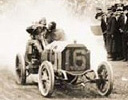Uncensored CART Commentary
by Ed Donath
Bang for the Buck
9/19/02
ATHENS, NY—Chief IRL apologist, charter driver/team owner Eddie Cheever reckons “…it will take $14
million to operate a two-car IRL team in 2003,” as reported by Robin Miller for ESPN.com.
"Have the costs doubled? Yes they have," Cheever asks and answers his own question. "But the exposure has
gone up five times. The bottom line is that the value in the IRL is better."
Better than what?
Better than ever before? Well, maybe yes…but maybe no.
Giving due credit to the inheritor of the Indianapolis Motor Speedway for piggy-backing some races with
better-attended NASCAR events and for stepped-up ticket giveaways at distressed venues, he has managed to make
grandstands look at least five times more populated to race day channel surfers than ever before.
However, TV numbers—what sponsors really care about—are a whole ‘nother story. Audience share is still
pretty much nowhere; a fur piece from being value laden, especially when one considers ABC/ESPN’s vast network
capabilities and the league’s marquee event.
Cheever’s exaggerated estimate of quintupled IRL exposure since its inception hits an even more off-key
note when we realize that all but a handful of powerhouse teams are frantically chasing the sponsorships they
will desperately need in order to afford the increased price of oval poker in 2003.
Whether a recent rumor that $-challenged Eddie Cheever will opt to own and/or drive one or more of the 20
CART-subsidized Champ Cars next year proves to be true, the record shows that the former CART/F1 non-winner
has been forced to change sponsors in the IRL about as often as he has changed his soiled underwear—despite
his late-blooming success that includes an Indy 500 victory in 1998.
The recipient of factory testing program Infiniti engines during much of his IRL tenure, Cheever now finds
himself with an even bigger nut to crack—having to actually buy into an engine program. Whether he chooses
Toyota, Honda or the somewhat less pricey GM power mills, it could end up costing Cheever five times more for
engines than he’s ever had to shell out before.
"I think we spent something like $1.6 million the first year we ran,” Robin Miller quotes Cheever’s fellow
IRL charter driver Buzz Calkins’ team owner—his father. “It's going to take at least $5 million to run a car
next year and he [Buzz] is scrambling to try and find it,” the elder Calkins lamented.
On the other hand, it will be possible to run a competitive subsidized Champ Car for less than a field-filling
Indy car in 2003.
CART’s per-car cost will certainly not exceed $6.5 million—the figure which, after factoring-in chassis
tweaking, unique equipment, top shelf transportation and hospitality expenditures, is what it is costing Captain
Abandonment for his run in this year’s “cost efficient” IRL.
Perhaps Marlboro has received the value they had hoped for with Team Penske. However, now that open-wheel
racing costs have reached virtual parity, other potential sponsors might still be sitting on the IMS fence that
Helio Castroneves has claimed for his own personal post-race recreational activities.
Especially now, in light of all of stepped-up negative press and non-stop exodus stories the time has come
for Grandpa Chris and company to stop extolling the pit lane space-saving virtues of 18 to 20-car fields and
to get out there and actually sell the concept of comparative value.
“Bang for the buck.” That’s what we car guys have every right to brag about—and we certainly do—when our
product’s features and performance exceeds the competitions’ for the same money, or less.
Copyright © 2002 by Ed Donath and Deep Throttle. All Rights Reserved.
Ed Donath Archive
| 



